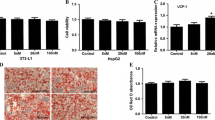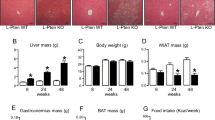Abstract
The UCP1 is an uncoupling protein located in the inner mitochondrial membrane of brown adipocytes, which has a well-documented role in diet-induced thermogenesis. The current study assessed whether UCP1 transfected liver cells demand more fuel substrates in the oxidative phosphorylation processes. Therefore, the purpose of this experiment was to achieve an ectopic expression of UCP1 in HepG2 cells to significantly decrease the production of ATP. The UCP1 gene was transferred into the hepatic cells by using a calcium phosphate precipitation protocol. The efficiency of the transfection was tested, 48 hours later, by bioluminescence of luciferase previously transfected, while the expression of mRNA of UCP1 was demonstrated by RT-PCR. In addition, measuring the production of ATP by using a bioluminescence procedure assessed the functionality of this protein. Transfected liver cells with UCP1 showed a decrease of 23% in ATP production in comparison with control cells without expression of UCP1 (2.23 vs. 2.90 RLU/pg protein, p=0.015). In conclusion, the ectopic expression of UCP1 decreased the production of ATP, possibly uncoupling the oxidative phosphorylation, which could be a novel approach for understanding thermogenic processes and eventually for energy metabolism and body weight management.
Resumen
La UCP1 es una proteína desacoplante localizada en la membrana interna mitocondrial del adipocito pardo, que tiene un papel importante en la termogénesis inducida por la dieta. El presente estudio fue diseñado para verificar si las células hepáticas transfectadas con el gen de la proteína UCP1 utilizan más substratos energéticos en los procesos de fosforilación oxidativa. Así, el propósito del experimento era lograr una expresión ectópica de la proteína UCP1 en células HepG2 para disminuir significativamente la producción de ATP. El gen de la UCP1 fue transferido a las células hepáticas usando un protocolo de precipitación del fosfato cálcico. La eficiencia de la transfección se demostraba 48 horas más tarde por bioluminiscencia de la luciferasa previamente transfectada, y la expresión del RNA mensajero de la UCP1, por RT-PCR. Además, la funcionalidad de la proteína se comprobaba mediante la medida de la producción de ATP usando un procedimiento de bioluminiscencia. Los resultados demuestran un descenso en la producción de ATP del 23% en las células hepáticas transfectadas con UCP1 respecto de las células control (2,23 frente a 2,90 RLU/pg proteína, p=0,015). En suma, la expresión ectópica de la UCP1 redujo la producción de ATP, posiblemente por desacoplamiento de la fosforilación oxidativa, lo cuál puede ser de interés para estudiar la importancia de los procesos termogénicos implicados en la regulación del metabolismo energético y el peso corporal.
Similar content being viewed by others

References
Bays, H. E. (2004):Obes. Res.,12, 1197–1211.
Bray, G. A. and Champagne, C. M. (2004):J. Am. Diet. Assoc. 104, 86–89.
Campión, J., Milagro, F. I. and Martínez, J. A. (2004):Nutr. Rev. 62, 321–330.
Cheng, S. H. and Smith, A. E. (2003):Gene Ther. 10, 1275–1281.
Erlanson-Albertsson, C. (2003):Acta Physiol. Scand. 178, 405–412.
Giacobino, J. P. (2002):Ann. N. Y. Acad. Sci. 967, 398–402.
Jezek, P., Zackova, M., Ruzicka, M., Skobisova, E. and Jaburek, M. (2004):Physiol. Res. 53 Suppl. 1, S199–211.
Klingenspor, M. (2003): Exp Physiol88, 141–148.
Larrarte, E., Margareto, J., Novo, F. J., Marti, A. and Martínez, J. A. (2002):Arch. Biochem. Biophys. 404, 166–171.
Marti, A., Larrarte, E., Novo, F. J., García, M. and Martínez, J. A. (2001):Int. J. Obes. Relat. Metab. Disord. 25, 68–74.
Marti, A., Novo, F. J. and Martínez, J. A. (1999):J. Physiol. Biochem. 55, 98A.
Nedergaard, J. and Cannon, B. (2003):Exp. Physiol. 88, 65–84.
Palou, A., Pico, C., Bonet, M. L. and Oliver, P. (1998): Int. J. Biochem. Cell Biol.30, 7–11.
Rodríguez, A. M. and Palou, A. (2004):Int. J. Obes. Relat. Metab. Disord. 28, 500–502.
Rolfe, D. F. and Brown, G. C. (1997):Physiol. Rev. 77, 731–758.
Rolfe, D. F., Newman, J. M., Buckingham, J. A., Clark, M. G. and Brand, M. D. (1999):Am. J. Physiol. 276, C692–699.
Roy, I., Mitra, S., Maitra, A. and Mozumdar, S. (2003):Int. J. Pharm. 250, 25–33.
Tros de Ilarduya, C., Arangoa, M. A., Moreno-Aliaga, M. J. and Duzgunes, N. (2002):Biochim. Biophys. Acta 1561, 209–221.
WHO/OMS Consultation group (2000):World Health Organ. Tech. Rep. Ser. 894, 1–253.
Author information
Authors and Affiliations
Rights and permissions
About this article
Cite this article
González-Muniesa, P., Milagro, F.I., Campión, J. et al. Ectopic UCP1 gene expression in HepG2 cells affects ATP production. J. Physiol. Biochem. 61, 389–393 (2005). https://doi.org/10.1007/BF03167056
Received:
Issue Date:
DOI: https://doi.org/10.1007/BF03167056



